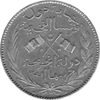Coins of the Comoro IslandsCoins issued on behalf of Sultan Said Ali ben Said Omar
The first coins minted specifically for use in the Comoro Islands were
those issued by Sultan Said Ali. Said Ali ben Said Omar was sultan ntibe
of the sultanate of Bambao on the west coast of the island of Ngazidja
(Grande Comore) and recognised by France, against all local tradition,
as sultan of the entire island. In 1886, and at his request, the island
became a French protectorate, a status it conserved until 1912.
Although his control over the island's fiscal policy was at best
limited, Said Ali had three denominations struck at the Monnaie de Paris mint in 1889: 5 centimes, 10 centimes and 5 francs. This Comorien franc
was equivalent to the French franc and divided into 100 centimes.
The three coins in theory ceased to be valid in 1912, but the lower two
denominations were still turning up in general circulation as late as 1930. The two bronze coins may still be found: although they are not in circulation they are frequently used for magico-religious purposes. The silver 5 franc coin is very rare.
All three coins bore similar inscriptions, including the date 1308 AH,
which corresponds to the years 1890/91 AD.
5 centimes
Two near-identical varieties of this coin were struck.
| 1a |

| 100 200 examples of this variant were minted in 1889. The coin is of bronze, has a net weight of 5 grams and a diameter of 25mm.
The edge is smooth. The engraver was Patey, although there is no signature
on the coin. The obverse bears inscriptions in Arabic, as does the reverse, the latter enclosed within a wreath of a palm frond and a laurel branch. Click on the image for further
details. |
| 1b |
|
200 000 specimens of this second variant were minted in 1901, despite
bearing the same date of 1308 AH. The obverse of 1b is identical to the obverse of 1a; the reverse of 1b bears a different privy mark. Further details may be obtained by clicking on the image of the reverse of 1a, above. |
10 centimes
This coin is identical to the 5 centimes coins, except in size and the different face value, and has also two variants.
| 2a |

|
50 200 examples of this variant were minted in 1889. The
coin is of bronze, has a net weight of 10 grams and a diameter of 30mm.
The edge is smooth. The engraver was Patey, although there is no signature
on the coin. The obverse bears inscriptions in Arabic, as des the reverse, the latter enclosed within a wreath of a palm frond and a laurel branch. Click on the image for further
details. |
| 2b |
|
100 000 specimens of this second variant were minted in 1901, despite
bearing the same date of 1308 AH. The obverse of 2b is identical to the obverse of 2a; the reverse of 2b bears a different privy mark. The 10 centimes coins are distinguished by the same privy marks that distinguish the 5 centimes coins. |
5 francs
A number of varieties of this coin were struck, all but one of which were tests. There is no record of how many specimens of each test were struck. They are distinguished by their rims (smooth or milled) their composition (silver or silver-plated copper) or their format (uniface or double-sided), . Most of the tests are extremely rare. The third variant, that which was finally issued is shown below. Notice that this coin has no face value.
| 3 |

| 2050 examples of this coin were minted in 1889. The
coin is of .900 silver, has a net weight of 25 grams and a diameter of 37mm.
The edge is a relief motif of 24 stars. The engraver was Patey, although there is no signature
on the coin. The obverse bears inscriptions in Arabic, encircling an arrangement of arms. The reverse of this coin again bears inscriptions in Arabic, enclosed within a wreath of a palm frond and a laurel branch. Also present are a crescent moon and star motif and two crossed flags, one French, the other Ngazidja. Click on the image for further
details. |
last updated 30/07/04
